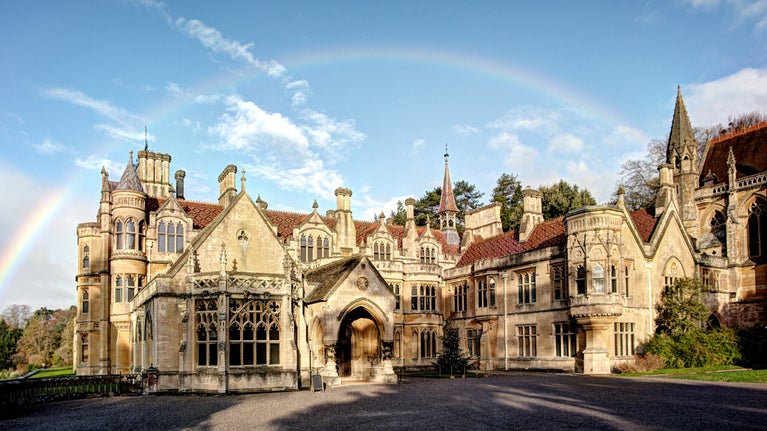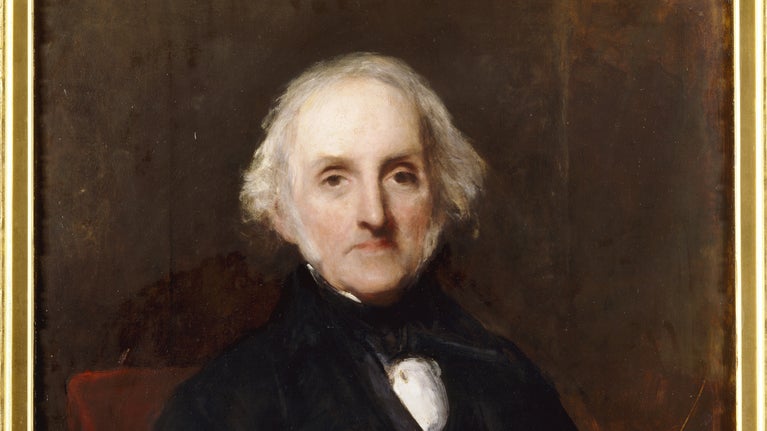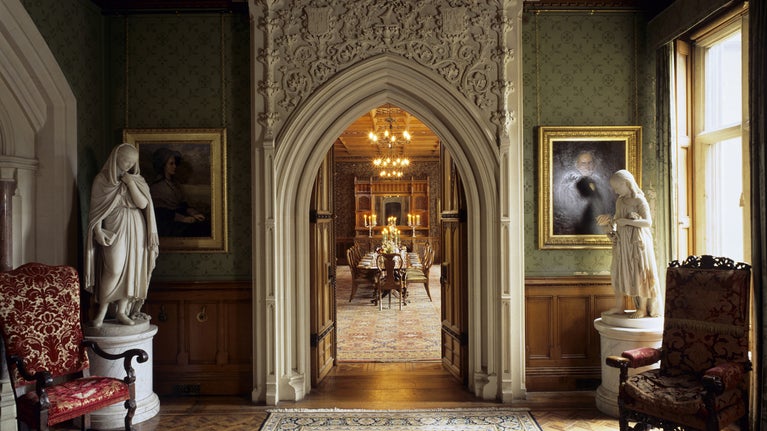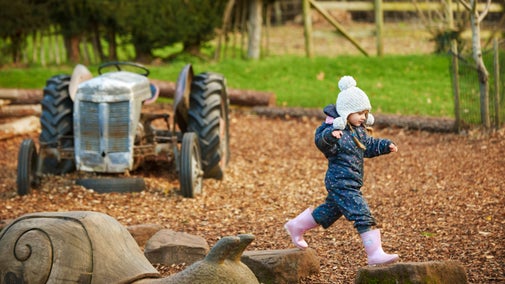
Discover more at Tyntesfield
Find out when Tyntesfield is open, how to get here, the things to see and do and more.

Tyntesfield, Somerset, is a 19th-century Gothic Revival house built on wealth from the trade in Peruvian guano by the Gibbs family. William Gibbs turned his business into a global trading powerhouse, making him one of the richest people in England. He and his wife Blanche hired leading Victorian designers such as John Norton and John Gregory Crace to create their home, filling it with a significant collection of art, set within formal gardens and parkland.
The name Tyntesfield refers to Tyntes Place, the ancestral home of the Tynte family of the Parish of Wraxall. By the 17th century the family had moved their primary home to Chelvey Court in nearby Nailsea. Tyntes Place, ancient and crumbling, was rented as a farm. In 1765, William Turner (d. 1804), the son of a successful timber merchant, obtained a lease from the Tyntes for land on the edge of the estate. Here he built a small Georgian country house called Belmont and bought the land from the Tyntes family in 1779. On his death the estate passed to the husband of his second cousin Louisa Cam (c. 1766–c. 1853), George Penrose Seymour (1765–1827). The Tyntes sold the remainder of their Wraxall landholdings, including Tyntes Place, to the Seymours in 1813.
The Revd. George Turner Seymour (1793–1880), is thought to have built the first Tyntesfield House near the site of Tyntes Place in the early 19th century in the early Gothic style. In 1844, William Gibbs (1790–1875) bought Tyntesfield House. He probably moved here to be close to his cousin George Gibbs, a merchant and trader of enslaved people, who then owned the neighbouring Belmont House.

Born in Madrid, Spain, William Gibbs left school at 12 to join his father, Antony Gibbs, in business. Their firm imported British cloth into Spain and exported Spanish wine and fruit to Britain. Tragedy struck in 1815 when Antony died unexpectedly, leaving massive debts. With his elder brother, William reformed the family business, eventually opening branches in Cadiz, London and Gibraltar. As Spanish colonial power declined, they expanded into South America, setting up trading houses along the Pacific coast which earned substantial profits.
Aged 49, he married 22-year-old Blanche Boevey-Crawley (1817–87) and a year later bought Tyntesfield. The couple made the final payment in 1844 and swiftly began making improvements, adding an icehouse, dairy, new servants wing and garden terraces. The couple commissioned decorator John Gregory Crace, who collaborated with architect Augustus Pugin on the British Houses of Parliament, to update the interiors.
After his brother’s death in 1842, William Gibbs became the head of the family business. Around the same time, the manager of the company’s Lima office signed a contract with the Peruvian government allowing the firm to export guano (seabird droppings) to Europe. William, at first reluctant to enter the trade, marketed the guano as a miraculous new fertiliser that could boost farmers' harvests and profits. In 1847, the Gibbs firm gained exclusive rights to export guano and William’s fortune exploded.
But the wealth came at a high cost. In the 1840s, the guano was extracted by labourers including former convicts, indentured Indigenous Peruvians, and military deserters. From 1849, indentured Chinese labourers working in dangerous, slavery-like conditions, did most of the work. Intensive mining caused devastating environmental damage to the seabirds and their ecosystems. Victorian engineer James Duffield claimed that after mining the Chincha Islands, where the deepest guano reserves were found, they looked like ‘vast sarcophagi, like anything in short that reminds one of death and the grave’.

William and Blanche used their guano fortune to transform Tyntesfield. In the 1860s, they hired architect John Norton to rebuild the house in the Gothic Revival style. Inspired by late medieval religious art and architecture, the style reflected the family’s devout Anglican Christian faith. Norton created a splendid family home, doubling Tyntesfield’s size and adding a magnificent oak-panelled library, an opulent drawing room and a grand Gothic conservatory.
Again, the couple hired decorator John Gregory Crace to design the interiors. They bought furniture from the finest craftspeople, including cabinet-maker James Plucknett, and filled their home with art. William and Blanche collected 17th-century Spanish paintings as well as British landscapes and seascapes. They also commissioned family portraits from fashionable artists such as William Boxall and John Lorimer.
The Gibbs family supported the Oxford Movement, who argued that Anglicanism was not a Protestant denomination but a branch of the historic Catholic Church. In the 1870s, William and Blanche completed their home by hiring architect Arthur Blomfield to build a private chapel inspired by the 13th century Sainte-Chapelle in Paris, France.
William died in 1875, shortly before the chapel was finished. Blanche ran the Tyntesfield estate throughout her widowhood, making several important improvements. She hired architect Henry Woodyer to add a veranda to the south front of the house and commissioned a magnificent carved oak hall stand from cabinet-maker James Plucknett. Blanche built the Home Farm, which aimed to showcase the family’s wealth, status and interest in innovations in applied science and agriculture.
Blanche continued her husband’s charitable legacy. William had been a committed philanthropist, paying for the construction of six churches and contributing towards the cost of building at least thirteen others. Blanche favoured more socially active causes, building a club and a temperance inn in the local village. Four of her seven children had died in young adulthood – three of tuberculosis. Blanche established the Cheddar Hospital, to provide the poor with convalescence for respiratory illnesses.

William and Blanche’s son Antony (1863–1907) inherited his father’s wealth, but not the family business. This passed to William’s elder brother’s son, leaving Antony free to establish himself as a cultured country gentleman. He travelled widely, was a talented ornamental turner and an enthusiastic art collector. Antony collected many of Tyntesfield’s finest treasures including Bellini’s ‘Madonna and Child with Saint John the Baptist’, now hanging in the Ante-room.
Antony married Janet Louisa Merivale (1850–1909) in 1872, and the couple spent the first 18 years of their married life at nearby Charlton House. When Antony finally inherited Tyntesfield, after the death of his mother in 1887, the couple updated their home. They installed electricity, and hired Arthur Woodyer to improve the interior, creating a more imposing circulation route from the Hall to the Drawing and Dining Rooms. Outdoors, the couple modernised the stables, remodelled the kitchen garden and added a fashionable orangery.
Antony and Janet’s son, the politician George Gibbs (1873–1931), later the 1st Lord Wraxall, inherited Tyntesfield in 1907. He had married Victoria de Burgh Long (1880–1920), known as Via, in 1901. The couple had one surviving child, Doreen. After Via’s early death George married Ursula Lawley (1888–1979). Together they had two sons, Richard (1928–2001), who would become the 2nd Lord Wraxall, and Eustace. Widowed after just four years, Ursula ran the house and estate until Richard was old enough to fully inherit the property aged 21.
After military training at Sandhurst and service in the Coldstream Guards, Richard Gibbs returned to Somerset, joining the North Somerset Yeomanry and later the Territorial Army. He devoted the rest of his life to managing the house, kitchen garden and estate, where he lived alone until his death in 2001. Richard, who never married, had no children. His will left the entire estate to 19 beneficiaries. Unable to keep the estate intact, they collectively placed the estate, and the house and contents, on the market.
The National Trust bought Tyntesfield in 2002, thanks to generous grants and public donations, saving the rare and remarkably complete Victorian estate. Tyntesfield opened to the public after only 10 weeks, offering visitors a unique behind-the-scenes look at the conservation programme. Ongoing representation and repair works, new visitor facilities, and restored gardens, allow more visitors to explore this extraordinary Victorian Gothic Revival country house and estate.
‘Tyntesfield’ Guidebook (National Trust, 2018)
Mark Girouard, ‘The Victorian Country House’ (Yale University Press, 1979)
James Miller, Fertile Fortune: The Story of Tyntesfield (National Trust, 2006)
Kilburn, M. (2011, May 19). Gibbs, William (1790–1875), businessman and religious philanthropist. Oxford Dictionary of National Biography. Retrieved 19 Jun. 2025. https://www.oxforddnb.com/display/10.1093/ref:odnb/9780198614128.001.0001/odnb-9780198614128-e-89656
Kinsley, L., ‘Guano and British Victorians: an environmental history of a commodity of nature’ (doctoral thesis, University of Bristol, 2020. https://researchinformation.bris.ac.uk/en/studentTheses/guano-and-british-victorians

Find out when Tyntesfield is open, how to get here, the things to see and do and more.
Looking for fun family activities to do? Whether you're after outdoor games for the kids or just a relaxing picnic in nature, we've got plenty for you to enjoy.

No National Trust place has a bigger collection of objects than Tyntesfield. Here, we highlight some of the things to look out for in the Gibbs family home, from the Grand Hall fireplace to an impressive hoard of books.

Learn about people from the past, discover remarkable works of art and brush up on your knowledge of architecture and gardens.

Explore the objects and works of art we care for at Tyntesfield on the National Trust Collections website.
